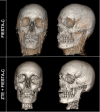Automated 3D MRI rendering of the craniofacial skeleton: using ZTE to drive the segmentation of black bone and FIESTA-C images
- PMID: 32772120
- PMCID: PMC7803710
- DOI: 10.1007/s00234-020-02508-7
Automated 3D MRI rendering of the craniofacial skeleton: using ZTE to drive the segmentation of black bone and FIESTA-C images
Abstract
Purpose: Automated bone segmentation from MRI datasets would have a profound impact on clinical utility, particularly in the craniofacial skeleton where complex anatomy is coupled with radiosensitive organs. Techniques such as gradient echo black bone (GRE-BB) and short echo time (UTE, ZTE) have shown potential in this quest. The objectives of this study were to ascertain (1) whether the high-contrast of zero echo time (ZTE) could drive segmentation of high-resolution GRE-BB data to enhance 3D-output and (2) if these techniques could be extrapolated to ZTE driven segmentation of a routinely used non bone-specific sequence (FIESTA-C).
Methods: Eleven adult volunteers underwent 3T MRI examination with sequential acquisition of ZTE, GRE-BB and FIESTA-C imaging. Craniofacial bone segmentation was performed using a fully automated segmentation algorithm. Segmentation was completed individually for GRE-BB and a modified version of the algorithm was subsequently implemented, wherein the bone mask yielded by ZTE segmentation was used to initialise segmentation of GRE-BB. The techniques were subsequently applied to FIESTA-C datasets. The resulting 3D reconstructions were evaluated for areas of unexpected bony defects and discrepancies.
Results: The automated segmentation algorithm yielded acceptable 3D outputs for all GRE-BB datasets. These were enhanced with the modified algorithm using ZTE as a driver, with improvements in areas of air/bone interface and dense muscular attachments. Comparable results were obtained with ZTE+FIESTA-C.
Conclusion: Automated 3D segmentation of the craniofacial skeleton is enhanced through the incorporation of a modified segmentation algorithm utilising ZTE. These techniques are transferrable to FIESTA-C imaging which offers reduced acquisition time and therefore improved clinical utility.
Keywords: Facial bones; Image processing, computer-assisted]; Magnetic resonance imaging; Skull; Three-dimensional imaging.
Conflict of interest statement
Dr. Delso is currently employed by GE Healthcare.
Figures







References
MeSH terms
Grants and funding
LinkOut - more resources
Full Text Sources
Other Literature Sources
Medical

